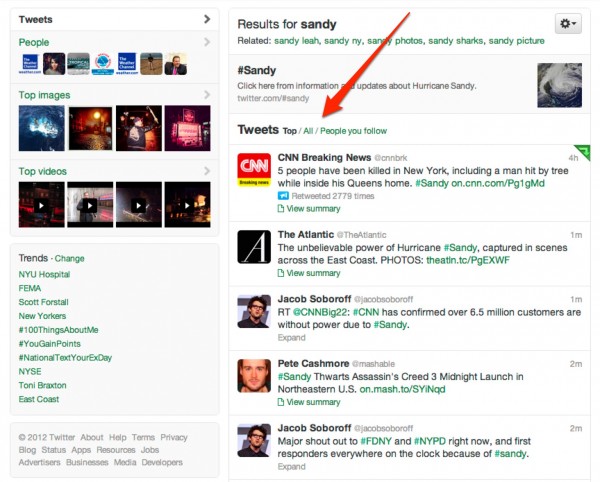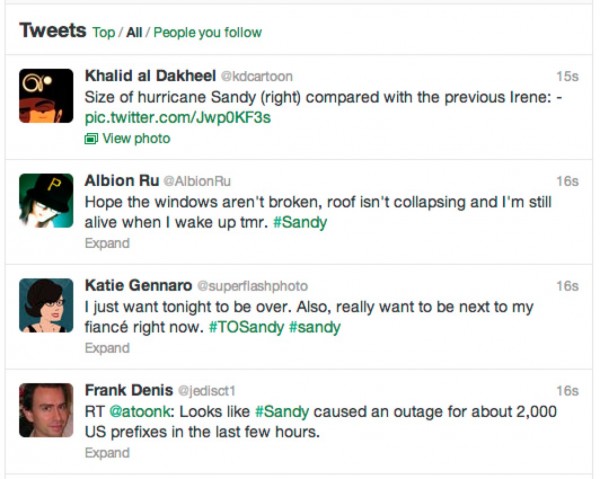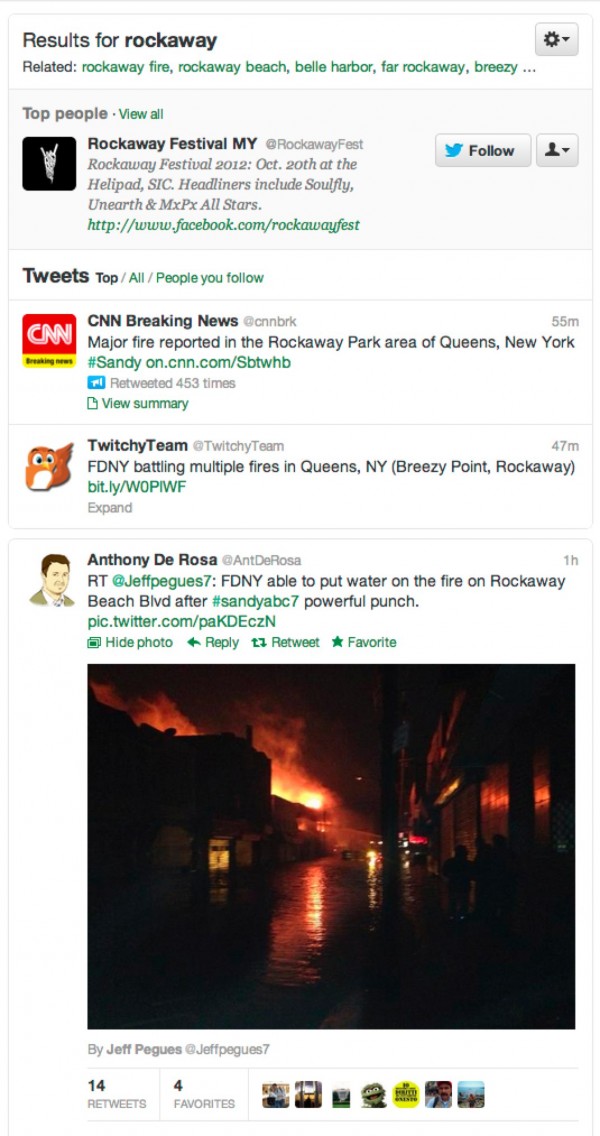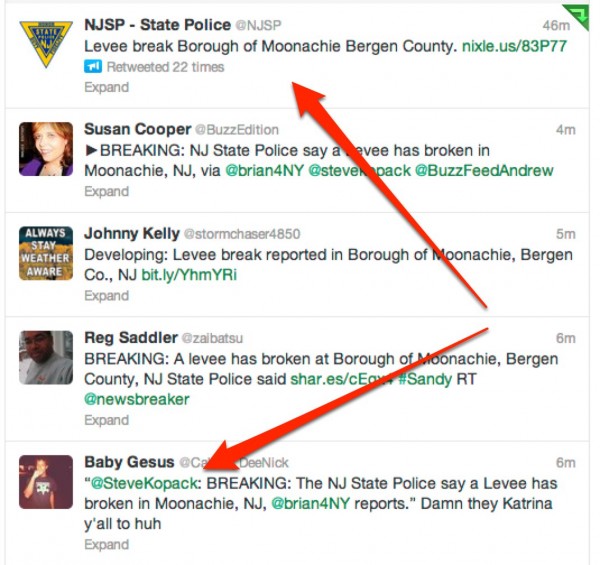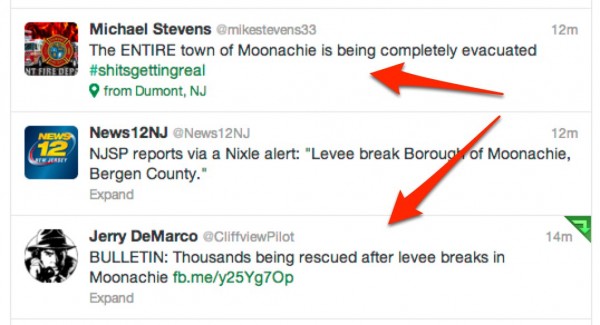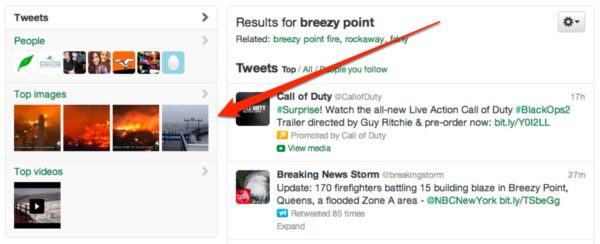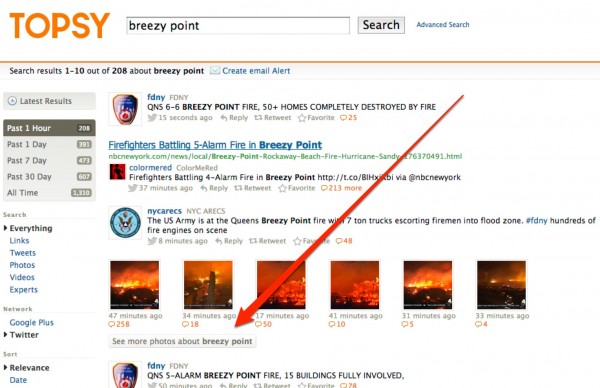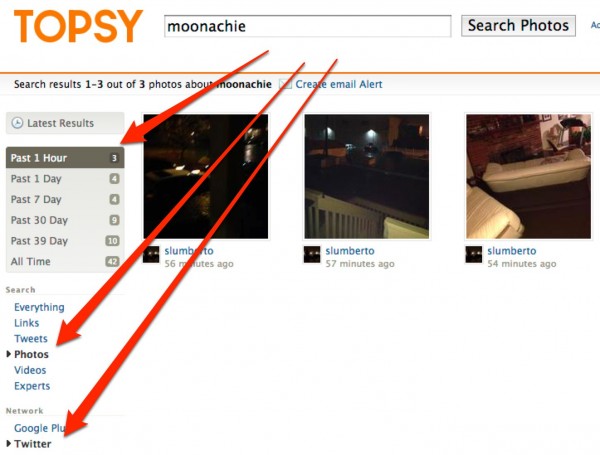Tracking Hurricane Sandy News Through Twitter
Like many, I’m transfixed watching the damage Hurricane Sandy is inflicting on the East Coast of the United States. But it’s Twitter, rather than national television news, that often seems a better way to watch for the latest. Below, some tips on how to tune-in on Twitter. Why focus on Twitter over other social media […]
Like many, I’m transfixed watching the damage Hurricane Sandy is inflicting on the East Coast of the United States. But it’s Twitter, rather than national television news, that often seems a better way to watch for the latest. Below, some tips on how to tune-in on Twitter.
Why focus on Twitter over other social media sites? The nature of Twitter lends itself to rapid-fire updates in a way that Facebook or Google+ don’t, where the posts tend to be more spread out.
The Sandy Hashtag Page
To make things easy for people, Twitter’s created a special Sandy hashtag page designed to collect high-quality, relevant tweets, plus list some top people to follow and show related pictures:
This is one of the new “hashtag” pages that Twitter introduced last June.
While you can get news via this page, another tip is to follow some of the accounts you see being surfaced on it. That can help ensure that Sandy-related news begins automatically flowing into your regular tweet stream, rather than having to go back to this page.
Connecting Through Disasters
A side benefit of following people is that you end up being connected to places in ways you might not ever have expected.
Over the years, I’ve ended up following people and news sources after the earthquakes that hit Japan and New Zealand, or the flooding along the Mississippi last year and recently the quake that hit off Haida Gwaii in British Columbia.
I like that I continue to have a link with these places past the immediate concern. I learn how they’re coping; I also learn new things about communities I never expected to be connected with.
Searching Twitter For Sandy
By default, the hashtag page will automatically update, though because there’s some behind-the-scene filtering going on, it might not be rapid-fire. Still, if you need extra time to review, there is a pause button next to the “View all Tweets” link:
As for that “View all Tweets” link, remember that I said that by default, tweets are filtered? If you want a broader range of tweets, click on that. You’ll shift away from the specially-tuned hashtag page to a page of regular search results on the topic:
These results, by default, are filtered to “Top” tweets, which means tweets that Twitter thinks are especially relevant and from high-quality sources. What you see will also be different than what others see, because Twitter tries to personalize these based on who you follow.
In the screenshot above, you’ll see an “All” link that the arrow’s pointing at. Click that, and you’ll get a fairly raw feed of everything coming in:
Searching For Hyperlocal News
The Sandy hashtag page or a search for “Sandy” may be enough for most people seeking major news developments. But I’m often curious about what’s happening in a particular area. For example, what’s going on in Rockaway, Queens, where I saw terrible tweets about fires raging and firefighters having to fight with flood water?
Not all those tweets are going to be using the word “Sandy” in them. So, a first step is a search on the area name, in this case, “rockaway.” That brought up this amazing picture, below:
Going to “All” tweets mode gives you a much more personal experience from more who are actually there:
Of course, there are going to be tweets that don’t use either an area’s name or the word “sandy.” That’s where filtering by geography may help, and the easy way to start is with Twitter’s advanced search page. Head over there, put the location of an area in the “Places” section (city, state, country — Twitter will guess fairly well), and search (leave all the other sections on the form blank). The downside is that I find these tweets are often noisy and sometimes don’t even seem to really be from the area.
Fact Or Fiction?
When the tweets come in, you have to be aware that there’s rumor and mistakes mixed in among the truth. How to know what’s really happening? A first step is to see if there are multiple, authorative sources citing the same thing.
For example, as I was working on this story, I came across something about a levee breaking in Moonachie, New Jersey. Real? I did a search for “levee,” figuring that most tweets that came up would likely be related to it:
The first tweet was from the New Jersey State Police, which tells you immediately this is real. But if it wasn’t from a government agency, start looking at the profiles of those tweeting or being retweeted. Are they from the area? Do they have other tweets?
See the second arrow pointing to @SteveKopack? Clicking on that profile tells you he’s a news assistant with CNBC, and you can see from his other tweets that he’s tracking all types of storm developments. That makes him a fairly trustworthy source, to me.
Of course, the media can be wrong. So can public agencies. What you really want are multiple first hand accounts.
Here’s another example. Watching the stream for “moonachie” tweets, I saw this:
The one at the top is from someone near Moonachie, in Dumont, New Jersey. There’s nothing that says how he knows this, however. But the second post is from the Cliffview Pilot, which looks to be a local news blog with an article citing a county employee who, with a little more searching, does indeed appear real. About 15 minute later, this came in:
Tony Gatto is an assignment editor for a New York TV station. He might be hearing this second hand, but there’s a good chance he’s actually spoken with the New Jersey State Police.
Searching For Pictures
So far, I’ve talked about tweets. But often, it’s the pictures that are being tweeted that communicate what’s happening more.
Here’s an example for a search on Breezy Point, where a fire broke out, as I mentioned earlier. Twitter’s search results show some images for this:
If you click on that, you’ll see a slideshow of images, along with their tweets:
Twitter used to show pictures in another way, where you could quickly see a variety of related images all at once. I desperately wish Twitter would bring that back. But without it, and if you’re still seeking images, Topsy might be able to help.
Topsy For Images
Topsy receives a full feed of tweets, so you can search through it just as you can search through Twitter. Here’s how a search for “Breezy Point” looks there:
You can see images appearing right in the results, and there’s a button (that the arrow points to) that makes it easy to get those images from the past hour:
The downside to Topsy is that despite its attempt to filter out duplicate pictures, you can still get a lot of them. Still, it’s well worth checking. Consider this:
Remember Moonachie, being flooded because of a levee break? Twitter wasn’t bringing up any pictures of that. But Topsy found some, when I searched for “moonachie” and narrowed to photos in the last hour from Twitter, as the arrows show.
The pictures come from @slumberto, one of the local firehouse being underwater and another, sadly, of couches floating in his (I think he’s a he) house:
Of course, you have to be careful with images. There are plenty of fake ones that go around. To help you with that. Alexis Madrigal has written a timely piece over at The Atlantic on how to tell what’s real.
Also be sure to see Twitter’s blog post today, which covers that special Sandy page I mentioned above as well as a variety of Twitter accounts that can be useful to follow. Related, Google has created a custom map for tracking the storm’s progress.
On a personal note, many employees of Third Door Media — our publishing company — are in the storm’s path, without power or phones, in some cases. The thoughts of their coworkers watching from afar are with them, as are our thoughts for everyone in the path.
Related Articles
- Hurricane Sandy Superstorm Online News, Search & Social Media Resources
- Google Has Launched A Hurricane Sandy Crisis Map
- Topsy: Now Searching Tweets Back To May 2008
- Twitter Search Gets “New Twitter” Look & Feel
- Here’s What Twitter Should Do To Make Photo Galleries More Useful
- Twitter Airs Its First TV Commercial, Promotes Its First Hashtag Page
- Twitter’s Second Hashtag Page Promotes Euro 2012, Continues Twitter’s Move Into Media
Opinions expressed in this article are those of the guest author and not necessarily MarTech. Staff authors are listed here.
Related stories


